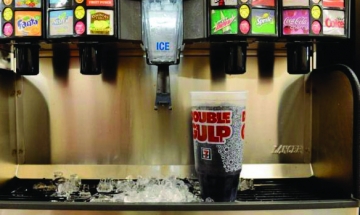Proposed ban pops debate about government, health
For Fajr Muhammad, there never seems to be enough time in the day. At 7 a.m. her alarm blares to wake her up for work, the sun just beginning to stream through the windows of her small, quaint apartment in Staten Island, N.Y. Even as she tears herself from her bed, the stylish and fit 29-year-old writer, blogger and copy writer is thinking about her day ahead, which involves public transportation, Starbucks, work and—if it’s a good week—spinning class.
Muhammad always tries to lead a healthy and active lifestyle, which means eating as healthy as possible, visiting the gym one to three times a week, and keeping soda to a minimum. So when she heard about New York City Mayor Michael Bloomberg’s regulation to restrict surgary drink sizes of more than 16 ounces, she didn’t lose sleep.
Not until she found out that her 20-ounce Starbucks’ VentiFrappuccino, macchiato, and other beloved coffee drinks also face the chopping block if they’re pre-sweetened or not made with at least 50 percent milk.
“Why does the government have to restrict our daily activity on that level?” Muhammad said sternly. “It’s not that what they’re trying to achieve is a horrible thing, but there are some families, especially low-income ones, who don’t always have the means to pick healthier foods. And they don’t have much choice but to eat the big and cheap meals that many fast-food places offer.”
Muhammad said there are other ways to help curb the obesity epidemic: more education on the health and food environment and more affordable, healthy “Green Carts,” which are mobile food carts that offer fresh produce in certain New York City neighborhoods.
“I like those kinds of initiatives; I’m not too big on restrictions,” she said. “It’s kind of alarming on how the government is restricting something so minuscule. It’s like a drop in the bucket.”
New York is often a leader when it comes to public health policy. When the city banned smoking and trans fats, other cities followed suit. So Bloomberg’s plan to restrict large sodas not only has the nation’s sweetened-beverage companies outraged, but it has simultaneously sparked discussion among citizens, policy makers and researchers.
Across the country, cities and states have approved legislation or regulations with the goal of making Americans healthier. According to the National Conference of State Legislatures, on Sept. 30, 2008, California became the first state to enact statewide menu labeling, requiring chain restaurants with 20 or more locations in the state to clearly show calorie and other nutritional information. Following in California’s footsteps, Maine, Massachusetts, Oregon, New Jersey and Tennessee have enacted menu-labeling legislation.
In 2008, California was the first to pass statewide legislation that would prohibit trans fats, or trans fatty acids, from being served or used in the preparation of foods in restaurants and other food facilities. It also banned foods containing trans fats from being served or used to prepare restaurant foods. Trans fats are produced by adding hydrogen gas to liquid vegetable oils to make them more solid. Trans fats can raise cholesterol levels and increase the risk of heart disease and strokes, according to the American Heart Association.
Last May, Colorado prohibited industrially produced trans fat in foods available to students in public schools. Philadelphia, Seattle and Baltimore have also banned trans fats.
Many other public-health policies have been proposed but never approved.
Jay Ostrich, director of public affairs at the Commonwealth Foundation, a Harrisburg-based organization that generally supports business interests and opposes government intervention in issues, said few legislatures welcome a “nanny state” that is perceived as interfering with personal choice.
“The majority of people do not want to be told what to do with their bodies, money or time,” he said. “So many states have officials that represent the will of the people. The majority of Americans want to be free and don’t want to see such laws pass, so they fight to stop it.”
 Bloomberg’s policy, which is set to go into effect March 12, prohibits drinks of more than 16 ounces in food establishments regulated by the city. Businesses that sell food but are not regulated by the city, such as convenience stores, will not be affected. While consumers would no longer be able to buy a 32-ounce soda, they would still be able to buy two 16-ounce sodas.
Bloomberg’s policy, which is set to go into effect March 12, prohibits drinks of more than 16 ounces in food establishments regulated by the city. Businesses that sell food but are not regulated by the city, such as convenience stores, will not be affected. While consumers would no longer be able to buy a 32-ounce soda, they would still be able to buy two 16-ounce sodas.
“When I hear about banning sodas and the government, the first question I ask myself is ‘Where do they get the authority to abrogate an individual’s right?’ ” said Francis Wojnicki, a lawyer and research associate at Penn State’s Department of Nutrition. “In other words, where does the government get the authority to say, ‘No you have to do this, you have to do that, you can’t eat this, you can’t eat that?’ I keep asking people, ‘Tell me where in Article 1, Section 8 of the Constitution do you find where Congress has the authority to do what it does, to regulate the way it does ...?’ ”
Wojnicki said when the government starts to regulate behavior, it takes away liberties that it should have no business being concerned about.
“At first they were going to have separate smoking sections, and then they made it ‘no smoking’ in restaurants, and then they made it ‘no smoking’ in bars, and now they’re making it ‘no smoking’ on the street,” he said. “Look through history. Every time there’s just a little bit of regulation, look at what happens X number of years down the line. The bureaucrats and the legislators are not happy and they keep increasing and increasing the regulation, which means they’re decreasing and decreasing your liberties.”
Rebecca Corwin, a professor of nutritional neuroscience at Penn State and wife of Wojnicki, also has a problem with the government’s restricting people’s choices.
Corwin objects to so-called “sin taxes” on food items such as soda because, in order for consumption to decrease, prices have to be increased to a level where it really hurts people in their pocketbooks.
“Where do you stop?” she said. “If you tax soda pop, next it will be doughnuts or Ho Hos or Twinkies, or whatever. The list is endless. And now you’re taxing food and if you’re going to raise it up high enough that people would actually reduce their consumption of doughnuts or soda pop, then you’re going to be affecting those who can’t afford to buy food. So essentially you’re punishing the poverty-ridden in the nation rather than those who are affluent and can afford this kind of stuff.”
Corwin said she understands why similar taxes on tobacco and alcohol, which are addictive substances, are used at least partially to decrease consumption. But she maintains that those policies can’t be compared to food. Tobacco and alcohol are not essential substances—the public knows they cause direct, harmful effects on the body—but people need to eat, she said.
“The burning question really is, if you ban sodas that are bigger than 16 ounces, does that make a difference in people’s consumption, and ultimately in their health? And I’m going to bet you it’s not going to make any difference whatsoever,” Corwin said. “It’s a silly, feel-good policy that was implemented to make the mayor look good, and it frightens me because it’s another way to chip away at individual liberties.”
Some people believe that refined foods and sugar are addictive and that government measures to influence consumer’s choices will therefore be ineffective.
Corwin said obesity and food-addiction policies are being based on science that is relatively new and still being formed.
She said the idea that sugar is addictive is from research by Nicole Avena, a neuroscientist at the University of Florida and Princeton University, and the late Bart Hoebel, a Princeton University professor of psychology and the Princeton Neuroscience Institute.
In a 2009 study published in The Journal of Nutrition, Avena and Hoebel concluded that sugary and fatty foods affect the brain and behavior differently than less fatty foods, such as fruits and vegetables. The research paper discusses how one group of rats would have sugar available to them at all times, while another group was given daily intermittent access to sugar dissolved in water.
The group of rats that had intermittent access to the sugar solution binged on those foods whenever they were offered. The researchers concluded that binging on sugar and fat had caused an addiction in the rats that mirrored the effects of drug abuse.
Corwin said she has done studies with rats in relation to fat and has had results similar to those found by Avena and Hoebel.
“So right from the get-go, that’s got to tell people, that this whole issue of food addiction is not due to the food,” Corwin said. “It’s the way it’s provided or the environment under which it’s consumed, or the amount consumed in a single bout, or something. And we don’t know what that something is.”
Not every scholar agrees with Corwin and Wojnicki.
Roberta Friedman, director of public policy at the Rudd Center for Food Policy and Obesity at Yale University, said Bloomberg’s public health policies aren’t meant to limit people’s freedom but to encourage them to think about what they’re putting into their bodies.
“You could buy 10 [sodas] if you wanted. Of course that would be absurd, but nobody’s telling you that you can’t drink 32 ounces,” Friedman said. “It’s just a nudge in the right direction, to encourage people to think about stopping after 16 ounces, because that’s a lot of sugar, that’s a lot of calories. It’s empty nutrition in those calories, and it’s not good for people.”
Brian Elbel, an assistant professor of population health and health policy at New York University School of Medicine, has done research on health policies, including calorie menu labeling and Bloomberg’s soda restriction.
Elbel said a fair amount of evidence shows that Bloomberg’s policy could be effective.
In a July 2012 article in The New England Journal of Medicine, Elbel along with NYU scientists Jonathan Cantor and Tod Mijanovich analyzed two reports in which itemized receipts were collected from consumers at fast-food restaurants.
About 1,600 receipts listed a beverage. The researchers calculated the number of calories from the drinks purchased. Then they calculated what would happen to people’s calorie totals if a consumer picked the 16-ounce drink or chose instead to double up to 32 ounces.
“Our work found that if everyone right now who purchased more than 16 ounces switched down to 16 ounces in fast-food restaurants, you could see a 60-or-so calorie savings,” Elbel said. “But of course the big question mark is we don’t know how many people will shift down versus buying two or buying their sodas somewhere else. So I think it’s an open question how effective it could be. I think there definitely is a fair amount of evidence to show that it could influence people’s soda choices.”
Elbel said his research of calorie labeling on menus didn’t show as much promise. He said that while some people claimed they responded to the information, overall he found calorie counts ineffective in influencing people’s food choices, at least for now. But, he added, this could change over time or if the policy goes nationwide.
Another major policy that often meets with controversy is taxation of soda or other sugary beverages.
Currently, Friedman said, 34 states and Washington, D.C., have taxes on soft drinks, which includes soda and beverages like sports drinks, energy drinks and juice.
Elbel said a sugar-sweetened beverage tax could influence the poor more because it represents a greater proportion of their income. “It’s what’s called a regressive tax, so it’s more of their income than it is a rich person’s,” he said. “At the same time, many low-income individuals have a lower health status than higher-income folks, so it could also positively influence them from a health perspective.”
In an October 2009 report, “The Public Health and Economic Benefits of Taxing Sugar-Sweetened Beverages,” Kelly Brownell, director of the Rudd Center for Food Policy and Obesity at Yale University, and other researchers discussed how a tax on soft drinks can help combat obesity as well as raise funds for healthcare costs.
According to the report, while there are already modest taxes on soda in several states, it is not enough to affect consumption. On the other hand, the report suggested, a penny-an-ounce tax would more than do the trick.
In effect, the tax would raise an estimated $150 billion nationally over the next decade—money that advocates argue could be put toward the nation’s swelling healthcare costs while reducing soft-drink consumption.
A 2009 Rudd Center report on soft-drink taxes suggested that a 10 percent tax could result in about an 8 percent decrease in consumption and that the effects may be even higher for heavy users.
Another article, “Ounces of Prevention—The Public Policy Case for Taxes on Sugared Beverages” published in The New England Journal of Medicine, also cites evidence supporting soft-drink taxes. It was written by Brownell and Thomas Frieden, the New York City health commissioner from 2002 to 2009.
In 2008, a group of child and healthcare advocates in New York proposed a penny-an-ounce excise tax on sugar-sweetened beverages, with a projected 13 percent reduction in consumption, according to the Brownell-Friedman article. It goes on to say that even if one-fourth of the calories consumed from sugar-sweetened beverages are replaced by other food, the decrease in consumption would result in an average reduction of 8,000 calories per person per year. That translated to a weight loss of slightly more than two pounds a year for the typical person.
Kathleen Keller, an assistant professor in the Department of Health and Nutritional Sciences and Food Science at Penn State, said food policies such as New York City’s are beneficial to the public.
“I think the problem with all these policy changes that Bloomberg and other people have started is that if you try to measure the effectiveness of just one change, it’s not going to be effective,” Keller said. “Obesity is so complicated, and it’s influenced by many, many factors in our environment. I mean, I could name 10 or 12 factors just sitting here right now—the environment, portion size, energy density, sweetened beverages, lack of physical activity … there are just many, many factors.”
Keller said people have to think of it in context and that these policy changes are meant to be small changes that, when added up, will make a significant difference.
“I think the argument from the other side is that it’s an invasion in terms of the government, in terms of individual responsibility, that’s your own responsibility, and that may be true,” she said. “But there is a very strong argument that obesity is not really a disease where people make rational decisions.”
Keller said most people know McDonald’s food isn’t very healthy, but they still eat it because it tastes good and it’s cheap. So when people aren’t making rational decisions about their health, Keller said it’s reasonable for the government to help people make decisions easier.
On the topic of calorie counts on menus, Keller said she agrees with Brownell’s argument that people have the right to know what is in their food, whether they actually use the information or not.
“I think that is a reasonable argument, despite whether it’s effective, for 5 percent or 95 percent, people have the right to know what’s in their food,” she said. “If they’re not interested in it today, they might get a diagnosis of type 2 diabetes tomorrow and get put on a low-fat diet—and all the sudden, they’re interested in the information.”
Keller contends that no one is taking the right to buy unhealthy food from people but the policies are making it a little bit easier to get healthier foods.
She said she also doesn’t think people will regularly buy two sodas, because there is research to suggest that smaller serving sizes are effective in decreasing consumption.
“That’s why they’ve been selling these 100-calorie snack-pack items,” Keller said. With sodas, she said, some people might go back and get a refill, “but I think the dangerous part of having these giant sodas is that it’s too easy to just drink them because it’s there, because it’s available.”
Keller said the government has an obligation to fix the obesity problem, and there are many reasons the government is interested in what the public eats—for example, so the United States can have a healthy military.
Elbel said the government may not have all the answers, but it still needs to do something.
“I think the evidence shows that it’s hard to imagine how at least in the short term we’re going to get a large-scale change in obesity without some changes in the food environment,” he said.
“And it’s hard to imagine how you’re going to get changes in the food environment without some public policy. And if we’re not going to have them, we have to have something else, and it’s hard to imagine what that something else is.”







